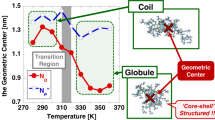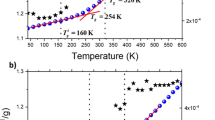Abstract
The conformations of single polymer chains in solution have been studied extensively since the 1940s. At high temperatures and in good solvents, a polymer has an extended coil configuration, while at low temperatures and in poor solvents a polymer is in a collapsed globule state. The transition between the extended and collapsed state as the temperature or solvent composition is varied was thought to be smooth and continuous, and experiments supported this idea1. However, in the 1960s it was suggested2–4 that the transition between the two configurations, the coil–globule transition, was discrete. We now report the first observations of the single polymer coil–globule transition. The observations were made on polyacrylamide molecules dissolved in acetone–water mixtures.
This is a preview of subscription content, access via your institution
Access options
Subscribe to this journal
Receive 51 print issues and online access
$199.00 per year
only $3.90 per issue
Buy this article
- Purchase on Springer Link
- Instant access to full article PDF
Prices may be subject to local taxes which are calculated during checkout
Similar content being viewed by others
References
Flory, P. J. Principles of Polymer Chemistry. (Cornell University Press, Ithaca, 1953).
Ptitsyn, O. B. & Eizner, Y. Y. Biofizika 10, 1–5 (1965).
Eizner, Y. Y. Polymer Sci. USSR 11, 409–417 (1969); 14, 1695–1706 (1972).
Lifshitz, I. M. Ah. Eksp. Theor. Fiz. 55, 2408–2422 (1968).
Edwards, S. F. in Critical Phenomena (eds Green, M. S. & Sengers, J. V.).
Domb, C. Polymer 15, 259–262 (1974).
Lifshitz, I. M., Grosberg, A. Y. & Khokhlov, Rev. mod. Phys. 50, 683–714 (1978).
De Gennes, P. G. J. phys. Lett. 39, 299–301 (1978).
De Gennes, P. G. J. phys. Lett. L 36, 55–57 (1975).
Mazur, J. & McIntyre, D. Macromolecules 8, 464–476 (1975).
Mashimo et al. J. Phys. Soc. Jap. 39, 1529–1537 (1975).
Nierlich, M., Cotton, J. P. & Farnous, B. J. chem. Phys. 69, 1379–1383 (1978).
Cuniberti, C. & Bianchi, U. Polymers 15, 346–350 (1974).
Tanaka, T. Phys. Rev. Lett. 40, 820–823 (1978).
Fillmore, D. J. & Tanaka, T. (in preparation).
Benedek, G. B. in Polarization, Matter and Radiation, 49–84 (Presses Universitaire de France, Paris, 1969).
Doty, P. & Edsall, J. T. Advances in Protein Chemistry Vol. 6, 35–121 (Academic, New York, 1951).
Nishio, I. & Wada, A. (in preparation).
Pecora, R. J. chem. Phys. 43, 1562 (1965).
Adam, M. & Delsanti, M. Macromolecules 10, 1229–1237 (1977).
Author information
Authors and Affiliations
Rights and permissions
About this article
Cite this article
Nishio, I., Sun, ST., Swislow, G. et al. First observation of the coil–globule transition in a single polymer chain. Nature 281, 208–209 (1979). https://doi.org/10.1038/281208a0
Received:
Accepted:
Published:
Issue Date:
DOI: https://doi.org/10.1038/281208a0
This article is cited by
-
Polymer coil–globule phase transition is a universal folding principle of Drosophila epigenetic domains
Epigenetics & Chromatin (2019)
-
Controlled self-organization of polymer nanopatterns over large areas
Scientific Reports (2017)
-
Unperturbed dimension, interaction parameters, zeta potential and rheology of sodium alginate in binary solvent mixtures
Journal of Polymer Research (2016)
-
Visualization of polymer relaxation in viscoelastic turbulent micro-channel flow
Scientific Reports (2015)
-
Self avoiding walk trees and laces
Journal of Mathematical Chemistry (2014)
Comments
By submitting a comment you agree to abide by our Terms and Community Guidelines. If you find something abusive or that does not comply with our terms or guidelines please flag it as inappropriate.



